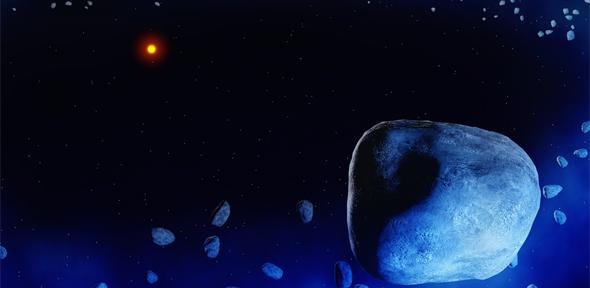Scientists Detect Frozen Comets Surrounding Young Sun-like Star
| Ana Verayo | | May 23, 2016 07:57 AM EDT |
(Photo : Amanda Smith, University of Cambridge) Illustration of the dust ring surrounding HD 181327
Scientists have detected frozen comets that are orbiting their young, host star that is similar to our sun which could provide important clues about the solar system's beginnings.
Using the Atacama Large Millimeter Array (ALMA), astronomers from the University of Cambridge discovered how HD 181327 is swarmed by millions of frozen comets in its system as they detected extremely low levels of carbon monoxide around the star. The presence of carbon monoxide in space is a telltale sign of comets, as comets in our solar system possess large amounts of this gas.
Like Us on Facebook
In this new study, scientists believe that these new findings can provide crucial insight about comet clouds and their properties that are located near sun-like stars during their early formation stages. According to lead author of the study, Sebastián Marino from the University of Cambridge's Institute of Astronomy, young star systems like the HD 181327 are very active as comets and asteroids collide and crash into each other and planets as well. This star system is also very similar to our solar system, which can be studied to learn more about the history and evolution of our solar system.
Scientists believe that Earth was similar to the appearance of Mars during the early stages of the solar system. However, comets began to arrive and smashed into our planet, creating massive impacts that brought essential elements and compounds such as water from space, that triggered the emergence of life.
This new star system is similar to the early solar system when comets collided with planets and other bodies as well, surrounded by dust and gases. Now, researchers are yet to confirm this theory using data from ALMA, by searching for gas signatures surrounding these comet and asteroid collisions, that created this dust ring around their star. Results revealed extremely low signatures of carbon monoxide gases.
Marino adds that this is the lowest gas concentrations ever detected from a comet and asteroid belt, and ALMA is now pushing its limits to detect more. The star HD 181327 is about 30 percent bigger than the sun, located some 160 light years away in the Pictor constellation. Scientists also estimated that this system is around 23 million years older that the solar system which is 4.6 billion years old.
This new study is published in the journal, Monthly Notices of the Royal Astronomical Society.
Tagscomets, asteroids, sun-like star, solar system, formation of solar system, ALMA
©2015 Chinatopix All rights reserved. Do not reproduce without permission
EDITOR'S PICKS
-

Did the Trump administration just announce plans for a trade war with ‘hostile’ China and Russia?
-

US Senate passes Taiwan travel bill slammed by China
-

As Yan Sihong’s family grieves, here are other Chinese students who went missing abroad. Some have never been found
-

Beijing blasts Western critics who ‘smear China’ with the term sharp power
-

China Envoy Seeks to Defuse Tensions With U.S. as a Trade War Brews
-

Singapore's Deputy PM Provides Bitcoin Vote of Confidence Amid China's Blanket Bans
-

China warns investors over risks in overseas virtual currency trading
-

Chinese government most trustworthy: survey
-

Kashima Antlers On Course For Back-To-Back Titles
MOST POPULAR
LATEST NEWS
Zhou Yongkang: China's Former Security Chief Sentenced to Life in Prison

China's former Chief of the Ministry of Public Security, Zhou Yongkang, has been given a life sentence after he was found guilty of abusing his office, bribery and deliberately ... Full Article
TRENDING STORY

China Pork Prices Expected to Stabilize As The Supplies Recover

Elephone P9000 Smartphone is now on Sale on Amazon India

There's a Big Chance Cliffhangers Won't Still Be Resolved When Grey's Anatomy Season 13 Returns

Supreme Court Ruled on Samsung vs Apple Dispute for Patent Infringement

Microsoft Surface Pro 5 Rumors and Release Date: What is the Latest?










